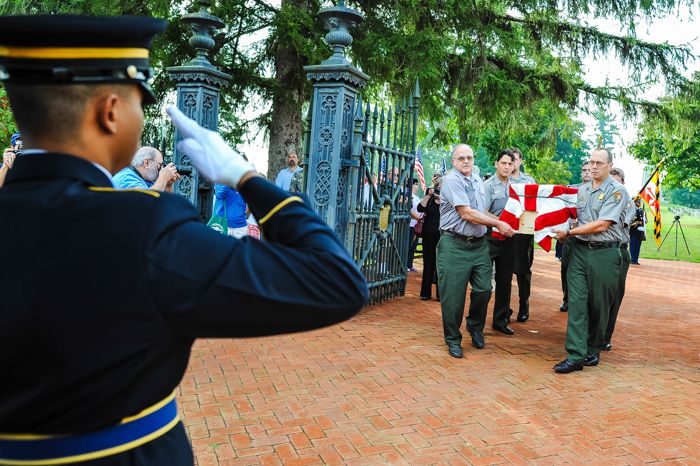Just days before Sept. 17, the 147th anniversary of the Battle of Antietam in Sharpsburg, Md., an unknown Union Civil War Soldier was sent off to his home state of New York for a proper burial with military honors. A hiker from Oklahoma recently found the remains while walking on a trail near the battlefield. He spotted disturbed ground and decided to look closer.
Jim Rosebrock, Jr. is an Antietam volunteer. He is the son of a retired Army Soldier who is also an Antietam volunteer. The Rosebrocks are dressed in Union uniform, each with an Enfield rifle, a European firearm, which fires a .58 caliber bullet.
The Battle of Antietam on Sept. 17, 1862, was the bloodiest one-day battle in American History. It left 23,000 Soldiers killed, wounded or missing after 12 hours of combat. This battle was the first invasion of the North by Confederate General Robert E. Lee and the Army of Northern Virginia. The New York National Guard accepted the transfer of remains of the Unknown Soldier from the Maryland National Guard.
The 12-hour battle began at dawn on Sept. 17th. The unknown Soldier was under the command of Maj. Gen. Joseph Hooker who led the first Union assault. Six Park Rangers, specially selected to perform this detail, carry the empty coffin to the place where the remains are located. The remains were placed in the coffin, and the coffin was nailed shut.
The New York National Guard’s Honor Guard unfolded a 34-star flag to place over the coffin. The flag was adopted with the admission of Kansas as the 34th state in January 1861 and used until 1863 when West Virginia became a state. The United States did not believe that secession was legal, thus the flag never lost any stars during the Civil War.
Members of the Maryland National Guard’s Honor Guard salute as the coffin containing the remains of the unknown Soldier is carried to the transport vehicle.
The New York National Guard’s Honor Guard accepted the transfer of the remains, which included a coat, a cuff, trouser buttons, a leather strap, a belt buckle and more than 400 bone fragments. The remains were placed in a replica Civil War era coffin and transported in a specially configured vehicle to Gerald B.H. Solomon Saratoga National Cemetery to be buried on Sept 17.

